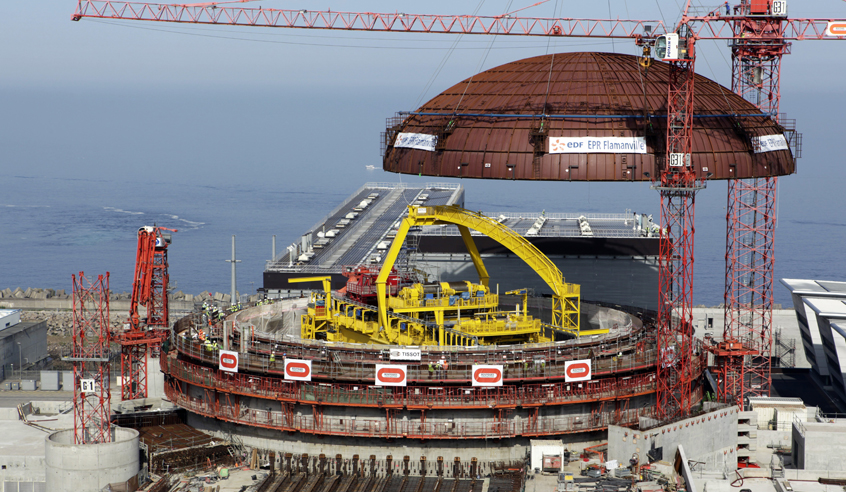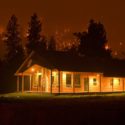Despite the fact that the EPR in Flamanville (Manche, France) has been under construction for seven years, French power utility EDF has yet to provide a satisfactory answer to some fundamental questions about nuclear safety. So much so that French official experts are calling a recent choice by EDF about the EPR’s safety “a step backwards”. Time is running out for the French utility, who has only a few months remaining to complete a demonstration of the safety of the EPR.
By Louis Germain and Martin Leers
Not only are the additional costs, delays and faulty workmanship of the EPR in Flamanville never-ending, but the very notion of the nuclear safety of the reactor is still a work in progress. Still, EDF touts the EPR as a nuclear reactor “equipped with a very high level of protection.” According to the designer and supplier of the EPR in Flamanville, Areva, it is “a reactor with an unparalleled level of security, extremely resistant to both internal and external risks.”
Experts at the French official Institute for Radiological Protection and Nuclear Safety (IRSN) paint another picture.
In a report made public on December 4th of last year, the IRSN explains that EDF has made a technical choice on a crucial piece of equipment for the safety of the EPR reactor which “constitutes a step backwards in terms of safety when compared with the design of the reactors of operating nuclear power plants.” What is this part so vital to the EPR’s safety?
It concerns a safety valve on the pressurizer. Much like the valve on a pressure cooker, which allows for relieving pressure to keep the cooker from exploding, the safety valve allows steam to escape in case the pressure becomes too great in the primary circuit. This valve is located on the pressurizer, which is responsible for regulating the pressure and temperature of the primary circuit, which contains the nuclear fuel and where water circulates to cool it. Uncontrolled excess pressure in the reactor pressure vessel could lead to its rupture, a major nuclear accident.
Inversely, a stuck-open safety valve would continuously discharge steam, and could lead, in conjunction with other malfunctions, to the emptying of the primary circuit and a nuclear meltdown. The director of the nuclear power plant division of French Nuclear Safety Authority (ASN), Thomas Houdre confirms that the role of this valve is “to avoid accidents, to avoid rupturing the primary circuit, and to ensure the containment of radioactive material.”
One of the main causes of the major nuclear accident on Three Mile Island (USA) in March of 1979 arose from a stuck-open valve. Since the building of the first French pressurized water reactors, several failures of safety valves on pressurizers have led to their replacement by safety valves working “in tandem”: a second valve below the first safety valve enables the backup valve to shut if the first one fails to do so.
EDF asks for the waiver of a key element of the EPR’s safety
Nevertheless, on the EPR in Flamanville EDF has decided to use a single valve instead of this double valve, and has asked the ASN for a waiver to exclude from the safety studies the failure of the valve to shut. But Karen Herviou, EPR’s project chief at IRSN, explained to Le Journal de l’énergie, “if the valve does not close, it becomes impossible to isolate this leak in the EPR.”
Thus, the EPR presented as “the authority on safety” could be using a less reliable part than the one being used on reactors already in operation in France, the oldest of which have been operating for more than thirty years. It becomes clear why the IRSN sees EDF’s choice as “a step backwards,” and asks EDF to justify it with results from in-depth studies. The French utility puts forth as its defense the significant reliability of the single valve, which is used on a large portion of German nuclear reactors, but will have to be modified for the EPR.
In a letter dated October 24th of last year, the ASN has honored the request of the IRSN and refuses to give the valve a waiver that it considers unacceptable. Thomas Houdre affirms: “EDF has not yet proven the capacity of the valve to close reliably.” Why does EDF want to revert to using a part whose reliability has not been proven, and which compels it to ask for an exemption from safety studies, when a valve with an additional safety feature, already in use on its nuclear power plants, is available?
Is EDF trying to save money on a part which is paramount to the nuclear safety of the EPR, already five billion euros over budget?
The power utility declined to answer this question. EDF hid behind an email response sent to Le Journal de l’énergie on December 11th: “We are in a normal process of technical inquiry. We are pursuing our communication with the IRSN and the ASN in order to provide evidence that the EPR in Flamanville meets all safety requirements.” There’s the rub. How is it that such questions determining the nuclear safety of the EPR have not yet been answered when this reactor should have been up and running for more than two years?
Why are there still discussions on the EPR’s fundamental safety components when the reactor has been under construction for seven years?
The EPR’s emergency diesel generators are not in perfect running order
The sticking points on safety of the EPR reactor do not just concern the primary circuit, far from it.
An essential piece of safety equipment whose unavailability led to the Fukushima nuclear catastrophe in March of 2011 is also subject to criticism by the IRSN, in a report addressed to the ASN and dated July 18, 2014. It questions the EPR’s emergency diesel generators which supply power to the reactor when external power supply has been lost. A reactor loaded with nuclear fuel is completely dependent on a permanent supply of power in order to cool the nuclear reactor core and the spent fuel immersed in the storage pool. The emergency generators provide essential electricity in case of power losses, without which the fuel begins to melt and the reactor spins out of control.
Yet the IRSN ascertains that EDF’s demonstration of “the protection of the main diesel engines against ‘cold snaps’ and fires as well as for the long term functioning of the diesel engines in case of an earthquake” is incomplete. In addition, “the current design holds no guarantees that the main diesel engine will restart after a stoppage.” In other words, if one of the emergency diesel engines stalls, there is no assurance that it will restart. However, these EPR emergency generators must be able to operate continuously for two weeks during a loss of external power due to an earthquake. Moreover, these generators might not be able to provide enough power in case of need: “the IRSN notes that the margin of available power seems weak in light of feedback from functioning reactors.” That’s not all. The IRSN underscores a series of inadequacies in demonstrations provided by EDF on the reliability of these generators and concludes that “the studies conducted on these main diesel generators bring to light the need for more information on the part of EDF in order to be able to rule on how well safety objectives have been attained.”
If these diesel engines stopped functioning, two other diesel engine generators, less powerful, said to be “the ultimate lifesaver” would take over the job. But there too the IRSN gives EDF a failing grade in another report dated July 9, 2014. These generators were not designed to meet the power needs of the nuclear reactor core and of the spent fuel pools simultaneously. Moreover, their autonomy and the reliability of the starting or restarting of these generators are insufficient. Sylvie Cadet-Mercier, head of reactor safety at IRSN, told Le Journal de l’énergie, “At this stage, safety has not been demonstrated sufficiently.”
For the record, Areva’s former CEO Anne Lauvergeon, had declared at the time of the Fukushima accident: “If there had been EPRs at Fukushima, the possibility of leaks into the environment would not have existed, no matter what the situation.” We are measuring the gap between these statements and reality. So many flaws and shortcomings in a reactor billed as the last word in safety makes you wonder.
The nuclear safety of the EPR in Flamanville still has not been demonstrated
Why so many areas of uncertainty about the EPR, which has been in the works since 2007?
Because EDF and Areva have put the cart before the horse. Karine Hervou (IRSN) states: “From the beginning, the time frame for the construction of the EPR was an ambitious one, much more ambitious than the time allotted for nuclear reactors already in operation. This time frame was not realistic.” And according to the IRSN expert, “the EPR is certainly under much more pressure to demonstrate its safety than has been the case in the past.”
Even though the EPR was developed in 1992, in 2014 its nuclear safety report is still underway. Clearly EDF still has to make its case for the nuclear safety of the EPR, the number one selling point for building the reactor in Flamanville. Its design can still evolve until the operating license application is submitted, which EDF has announced for March 2015 according to our information. It is therefore urgent that in the next three months EDF try to reinforce its poorly put together arguments to avoid announcing further delays.
If the issue of the nuclear safety of the EPR is still unresolved today, the question arises as to what was sold to the French people under the name of the EPR by Areva, EDF and the authorities at the time of the public debate on the EPR in 2005. What was the basis for the EPR’s supposed “unparalleled level of safety” claimed by Areva?
At the time no safety report was available on the EPR since EDF had decided not to publish the preliminary report on the safety of the reactor for the public debate. In its entry in the EPR’s public debate report, the Association of Scientists for Information on Nuclear Energy (GSIEN) pointed out that the arguments in favor of the EPR are not supported by any accessible EDF technical document and, in fact, are only more or less dogmatic acts of faith. On reading the IRSN’s 2014 expert safety reports on the EPR, one finds EDF does not seem to have really changed its ways.
The association of scientists further drove their point home with an analysis which remains relevant almost ten years later:
“The file as we know it at this moment shows that numerous uncertainties must be resolved prior to any decision. Impasses are too often arrived at, leaving time-sensitive questions unanswered. And when the answers or the solutions come at a stage of construction when they can no longer be taken into account, it is customary to make do with more or less effective stop-gap measures, supported by brilliant calculations put forth to “justify” the technical shortcomings. These palliative measures only help to ease the consciences of the decision makers.”
This article was first published online on December 2014 in French in Le Journal de l’énergie.
Picture: The dome of the Flamanville EPR reactor building is put in place, July 2013, EDF.



